1、数据库表关系
1.一对多
为什么需要,重复字段太多
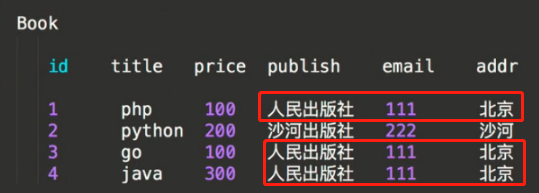
一对多关系表
Book id title price publish_id 1 python 100 1 2 php 200 2 3 go 100 1 4 java 300 1 Publish id name email addr 1 人民出版社 123@qq.com 北京 2 南京出版社 456@qq.com 南京 #总结:一旦确定表关系是一对多:在多对应的表中创建关联字段,publish_id #查询python这本书的出版社的邮箱(子查询) select Publish.email from Publish where Publish.id = () select Book.publish_id from Book where Book.title='python'
2.多对多
Book id title price publish_id 1 python 100 1 2 php 200 2 3 go 100 1 4 java 300 1 Author id name age addr 1 alex 34 beijing 2 jack 33 nanjing Book2Author id book_id author_id 1 2 1 2 2 2 3 3 2 # 总结:一旦确定表关系是多对多:创建第三张表 Book2Author id book_id author_id # alex出版过的书籍名称(子查询) select Book.title from Book where Book.id in () select Book2Author.book_id where author_id = () select Author.id from Author where Author.name='alex'
3.一对一
Author id name age ad_id(unique) id addr gender tel gf_name 1 alex 34 1 1 beijing male 110 小花 2 jack 33 2 2 nanjing female 999 红娘 # 为了解耦 #方式1: Author id name age ad_id(unique) 1 alex 34 1 2 jack 33 2 AuthorDetail id addr gender tel gf_name 1 beijing male 110 小花 2 nanjing female 999 红娘 #方式2: Author id name age 1 alex 34 2 jack 33 AuthorDetail id addr gender tel gf_name author_id(unique) 1 beijing male 110 小花 1 2 nanjing female 999 红娘 2 #总结:一旦确定关系为一对一:在两张表中的任意一张表中建立关联字段+Unique
2、sql语句创建关联表
Publish Book Author Book2Author AuthorDetail
create table publish( id int primary key auto_increament, name varchar(20) ); create table book( id int primary key auto_increament, title varchar(20), price decimal(8,2), pub_date date, publish_id int, foreign key(publish_id) references publish(id) ); create table authordetail( id int primary key auto_increament, tel varchar(20), ); create table author( id int primary key auto_increament, name varchar(20), age int, authordetail_id int unique, foreign key(authordetail_id) references authordetail(id) );
create table Book2Author( id int primary key auto_increament, book_id int, author_id int, foreign key(book_id) references book(id), foreign key(author_id) references author(id) );
3、ORM生成关联表模型
一对一
""" 1对1 author create table author( id int primary key auto_increament, name varchar(20), age int, authordetail_id int unique, foreign key(authordetail_id) references authordetail(id) ); create table authordetail( id int primary key auto_increament, tel varchar(20), ); """ # 作者表 class Author(models.Model): nid = models.AutoField(primary_key=True) name = models.CharField(max_length=32) age = models.IntegerField() # 1对1 # authordeatil = models.OneToOneField(to=AuthorDetail, to_field=nid) # 如果AuthorDetail表在后面定义也可以找到 # authordeatil = models.OneToOneField(to="AuthorDetail", to_field="nid") # 推荐使用字符串格式, # django2.0 会报错,级联删除 authordeatil = models.OneToOneField(to="AuthorDetail", to_field="nid", on_delete=models.CASCADE) # 作者详情表 class AuthorDetail(models.Model): nid = models.AutoField(primary_key=True) birthday = models.DateField() telephone = models.BigIntegerField() addr = models.CharField(max_length=32)
一对多、多对多
""" 一对多 Book -- Publish create table publish( id int primary key auto_increament, name varchar(20) ); create table book( id int primary key auto_increament, title varchar(20), price decimal(8,2), pub_date date, publish_id int, foreign key(publish_id) references publish(id) ); """ # 出版社表 class Publish(models.Model): nid = models.AutoField(primary_key=True) name = models.CharField(max_length=32) city = models.CharField(max_length=32) email = models.EmailField() # 书籍表 class Book(models.Model): nid = models.AutoField(primary_key=True) title = models.CharField(max_length=32) price = models.DecimalField(max_digits=5, decimal_places=2) publishDate = models.DateField() # 1对多关系 # publish = models.ForeignKey(to=Publish, to_field='nid') # django2.0 会报错,级联删除 publish = models.ForeignKey(to=Publish, to_field='nid', on_delete=models.CASCADE) # 多对多 authors = models.ManyToManyField(to="Author") # manytomany不会报错级联删除 """ 多对多 Book---- Book2Author ---- Author create table Book2Author( id int primary key auto_increament, book_id int, author_id int, foreign key(book_id) references book(id), foreign key(author_id) references author(id) ); """
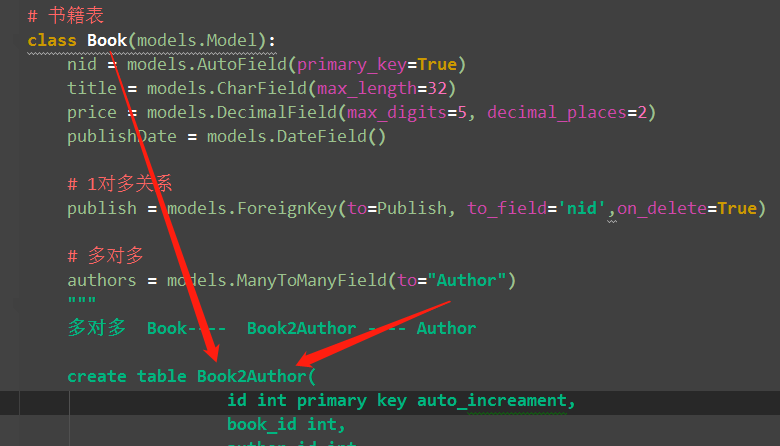
多对多可以 继续定义Book2Author, 推荐使用ORM的 ManyToManyField

4、生成数据库表
级联删除错误
C:PycharmProjectsORM2>python manage.py makemigrations Traceback (most recent call last): File "manage.py", line 15, in <module> execute_from_command_line(sys.argv) File "C:PycharmProjectsORM2app01models.py", line 72, in <module> class Author(models.Model): File "C:PycharmProjectsORM2app01models.py", line 79, in Author authordeatil = models.OneToOneField(to="AuthorDetail", to_field="nid") TypeError: __init__() missing 1 required positional argument: 'on_delete'

# 级联删除字段 on_delete=models.CASCADE 一对多 一对一 publish = models.ForeignKey(to=Publish, to_field='nid', on_delete=models.CASCADE) authordeatil = models.OneToOneField(to="AuthorDetail", to_field="nid", on_delete=models.CASCADE) # authors = models.ManyToManyField(to="Author") 多对多 不会报错
python manage.py makemigrations
python manage.py migrate
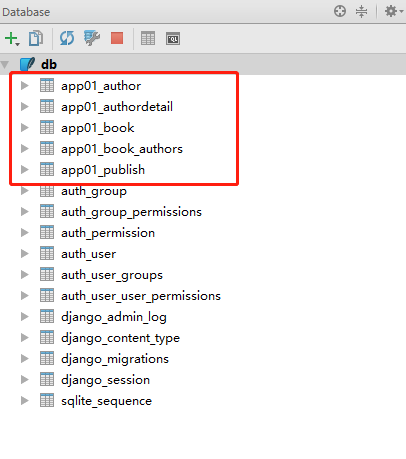
注意事项:
- 表的名称
myapp_modelName,是根据 模型中的元数据自动生成的,也可以覆写为别的名称 id字段是自动添加的- 对于外键字段,Django 会在字段名上添加"_id" 来创建数据库中的列名
- 这个例子中的
CREATE TABLESQL 语句使用PostgreSQL 语法格式,要注意的是Django 会根据settings 中指定的数据库类型来使用相应的SQL 语句。 - 定义好模型之后,你需要告诉Django _使用_这些模型。你要做的就是修改配置文件中的INSTALL_APPSZ中设置,在其中添加
models.py所在应用的名称。 - 外键字段 ForeignKey 有一个 null=True 的设置(它允许外键接受空值 NULL),你可以赋给它空值 None 。
5、多表操作 添加记录
url
from django.contrib import admin from django.urls import path, re_path, include urlpatterns = [ path('admin/', admin.site.urls), re_path(r'^app01/', include(('app01.urls', 'app01'))) ]
from django.urls import path, re_path, include from app01 import views urlpatterns = [ re_path(r'^add/$', views.add, name='add') ]
1.单表
from django.shortcuts import render,HttpResponse # Create your views here. from app01.models import * def add(request): # 1.单表添加记录 ret1 = Publish.objects.create( name='人民出版社', city='beijing', email='123@qq.com', ) ret2 = Publish.objects.create( name='南京出版社', city='nanjing', email='456@qq.com', ) print(ret2) # Publish object (2) return HttpResponse('OK')


2.一对多,一对一
绑定一对多的关系
方式1 方式2都有对象产生
(1) 方式1
# 方式1 # 为book表绑定出版社 book_obj = Book.objects.create( title='西游记', price=100, publishDate="2012-11-11", publish_id=1, ) print(book_obj) # 西游记 print(book_obj.title) # 西游记 print(book_obj.price) # 100 print(book_obj.publishDate) # 2012-11-11 print(book_obj.publish) # Publish object (1) print(book_obj.publish_id) # 1


(2) 方式2
# 方式2 # publish_obj = Publish.objects.filter(id=2).first() # 没有id属性 publish_obj = Publish.objects.filter(nid=2).first() # 先查找publish_obj 对象 book_obj = Book.objects.create( title='红楼梦', price=200, publishDate="2012-11-11", publish=publish_obj, ) print(book_obj.title) print(book_obj.price) print(book_obj.publishDate) print(book_obj.publish) # 与这本书关联的出版社对象 print(book_obj.publish.email) # 出版社对象,可以继续点方法 print(book_obj.publish_id)
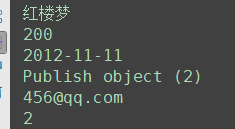
(3)查询
# 查询红楼梦的出版社对应的邮箱 book_obj = Book.objects.filter(title='红楼梦').first() print(book_obj.publish.email) # 456@qq.com
(4)一对一

author_obj = Author.objects.create( name='alex', age=22, authordetail_id=1, ) author_obj = Author.objects.create( name='jack', age=23, authordetail_id=2, )
3、多对多
(1)绑定多对多关系

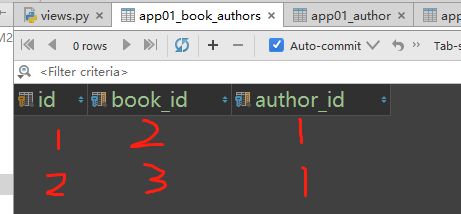
# 3.绑定多对多的关系 book_obj = Book.objects.create( title="大话设计模式", price=200, publishDate="2018-12-12", publish_id=1, ) alex = Author.objects.get(name='alex') jack = Author.objects.get(name='jack') # 绑定多对多关系的API book_obj.authors.add(alex, jack) # book_obj.authors.add(1, 2, 3) # eroor? book_obj.authors.add(*[1, 2, 3]) # 推荐 id_li = [1,2,3] book_obj.authors.add(*id_li)
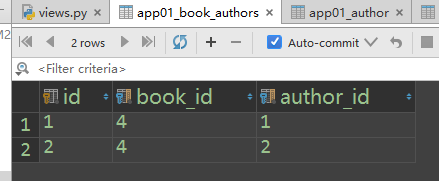
(2)解除多对多关系
# 4.解除多对多关系 book_obj = Book.objects.filter(nid=4).first() book_obj.authors.remove(2) book_obj.authors.remove(*[1,2]) book_obj.authors.clear()
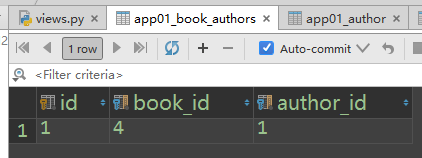
(3)多对多查询
# 查询主键为4的书籍的所有作者的名字 print(book_obj.authors.all()) # [obj1,obj2,...] querySet # 与这本书关联的所有作者对象集合 # <QuerySet [<Author: Author object (1)>]> ret = book_obj.authors.all().values('name') print(ret) # <QuerySet [{'name': 'alex'}]>
4、bulk_create多对多,添加
data
{ "alarm_info_id":797, "notifier_data":[ {"id": 2191, "channel": "010"}, {"id": 2392, "channel": "011"} ] }
实现
def record_notifier_channel(self, request, *args, **kwargs): """记录告警人和告警渠道""" # 根据alarm_info_id和告警人id,create记录 alarm_info_id = request.data.get('alarm_info_id') notifier_data = request.data.get('notifier_data') if not alarm_info_id: return self.render_to_json_response(status=1, msg='请输入alarm_info_id') # 取出数据 alarm_notifier_info_list = [] for notifier in notifier_data: alarm_notifier_info_list.append(AlarmInfoCustomerChannel( alarm_info=self.get_queryset().filter(id=alarm_info_id).first(), notifier=CustomUser.objects.filter(id=notifier.get('id')).first(), channel=notifier.get('channel'))) # 批量插入 try: AlarmInfoCustomerChannel.objects.bulk_create(alarm_notifier_info_list) return self.render_to_json_response(status=0, msg='记录成功') except Exception as e: return self.render_to_json_response(status=1, msg='记录失败%s' % str(e))
表结构
class AlarmInfoCustomerChannel(BaseModel): """某告警事件的告警用户和告警渠道""" alarm_info = models.ForeignKey(AlarmInfo, verbose_name='告警事件', on_delete=models.CASCADE) notifier = models.ForeignKey(CustomUser, verbose_name='告警通知用户', on_delete=models.SET_NULL, null=True) channel = models.CharField(verbose_name="通知渠道", max_length=3, null=True, blank=True)